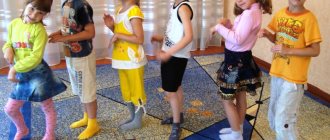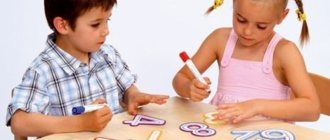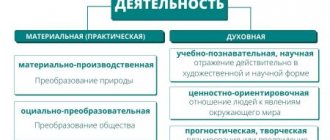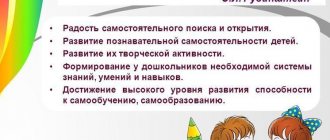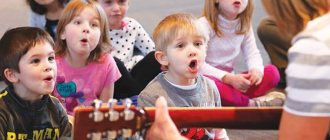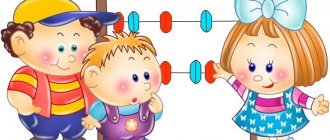The concept and essence of account and counting activities
Counting is an activity with finite sets. The account includes structural components:
goal (express the number of objects as a number), means of achievement (counting process, consisting of a series of actions reflecting the degree of mastery of the activity);
result (total number): it seems difficult for children to achieve a counting result, that is, a total, a generalization.
Developing the ability to answer the question “how much?” the words many, few, one two, the same, equally, more than speed up the process of children’s comprehension of the knowledge of the final number when counting. From the theory of arithmetic it is known that counting is the establishment of a one-to-one correspondence of elements between two sets being compared.
The main goal of doing mathematics is to give the child a sense of self-confidence, based on the fact that the world is orderly and therefore understandable, and therefore predictable for humans. The emergence of mathematical concepts occurred long before the appearance of mathematical texts themselves. The oldest mathematical activity was counting. An account was necessary to keep track of livestock and conduct trade. Some primitive tribes counted the number of objects by matching them with various parts of the body, mainly fingers and toes. A rock painting that has survived to this day from the Stone Age depicts the number 35 as a series of 35 finger sticks lined up in a row. The first significant advances in arithmetic were the conceptualization of number and the invention of the four basic operations: addition, subtraction, multiplication and division.
The first step or stage towards the emergence of counting was the establishment of a “one-to-one correspondence” between the objects being counted and some other set. The counting was based on one-to-one correspondences; “In some South African tribes, when counting, they touch each object in turn with their fingers, starting with the little finger of the left hand.” The most difficult stage that humanity went through in developing the concept of number is considered to be their separation of the concept of one from the concept of “many.” It happened, in all likelihood, even when humanity was at the lowest stage of development. V.V. Bobynin explains this selection by the fact that a person usually grabs one object with his hand, and this, in his opinion, distinguishes one from the many. Thus, the beginning of notation, according to Bobynin, is the creation of a system consisting of two representations: “unit” and “indefinite set”.
At the present stage, counting is the leading step in human education. From early childhood, a person strives to teach counting skills, which are used and improved throughout his life. The beginning of the development of numeracy skills is preschool mathematics education.
The founders of the system of mathematical education for preschoolers Ya.A. Komenskyi I.G. Pestalozzi believed that the foundations of arithmetic can be laid already in the third year of life, when children begin to count to five, and subsequently to ten, or at least begin to clearly pronounce these numbers. If in the fourth, fifth, sixth year they learn to count in order to twenty and quickly distinguish that 7 is more than 5, 15 is less than 30, then this will be enough.
In the pedagogical writings of the father of Russian didactics, K. D. Ushinsky, it is said that, first of all, children should be taught to count to ten on visual objects: on fingers, nuts, etc., which it would not be a shame to break if you have to show visually half, third, etc.
Formation of the concept of number in the process of learning to count in different age groups
Formation of the concept of number in the process of learning to count in different age groups
Integers -
these are numbers that arise in the process of counting individual objects (1,2,3 ... etc.) or measuring.
The main concept of elementary mathematics in kindergarten is the concept of number.
Work on developing this concept in children is carried out over three years (in the middle, senior and preparatory groups) and then continues in the primary grades of school.
Children's familiarization with numbers is prepared by practical exercises that combine two groups of objects, isolate individual elements from the group, and establish correspondences between the elements of two sets. From practical actions with objects, children gradually move on to counting them, become familiar with the first ten numbers of the natural series (their names, sequence), use these numbers to find out how each number is formed, and learn to compare them.
Learn to count -
means to be able to determine the total amount of something. When carrying out a counting operation, children learn the basic rules of counting: numerals are named in order; each named numeral corresponds to one object or one group, the last numeral corresponds to one object, but is an indicator of the total number of counting objects. indicated: “The goal of counting activity is to find the final number, and the means of achieving this goal is to name the numerals in order and relate them to each element of the set.”
When teaching children, it is important for the teacher to clearly perform counting actions: point to each object when naming numbers and make a circular gesture when naming the final number (“There are only four vases,” the teacher says and shows).
Teaching preschoolers to count will be more successful if the teacher uses visual methods. It is important that the child understands how each new number is obtained. The formation of an understanding of the formation of numbers and the relationships between numbers is carried out in the process of counting based on the comparison of two groups of objects, when the objects of each set are arranged in a row, one below the other. This arrangement helps children understand why each collection is called a different number. The teacher draws the children’s attention to the equality (inequality) of the number of objects in the compared groups, indicating that before answering the question “How much?”, one must count. Children in their fifth life develop an understanding of the connections between numbers: each next number is greater than the previous one and, accordingly, less than the next one.
When comparing the number of toys, note which toys are more, which are fewer, how many toys are in one group, how many in another. Then the numbers are compared: there are more nesting dolls than pyramids, 5 nesting dolls, 4, 5 pyramids more than 4. Inverse relationships are also established: there are fewer pyramids than nesting dolls, 4 pyramids, and 5, 4 dolls are less than 5.
Counting items that make up two populations, one containing more items than the other, provides the basis for comparing numbers. Gradually practicing comparing sets and, on this basis, comparing numbers, preschoolers learn that to get the next number it is enough to add one to a given number, and to get the previous one, you need to reduce (subtract) the number by one. So, when comparing numbers, you can ask: “Which number is greater than 7 by 1 (less than by 1)? How much more is 8 than 7? How much is 7 less than 8?” Then he shows the card and invites the children to count how many butterflies there are on it, and then name the number greater by 1. Then he asks them to name the number that will be obtained if 8 is increased by 1, if 9 is reduced by 1, name the number that, when counting, goes beyond the number 9. Children name the numbers 8 and 9. The teacher asks: “Which one is greater (less), by how much?”
Questions and tasks like these develop attention and contribute to the assimilation of the patterns of formation of numbers in the natural series.
In the older group
Preschoolers develop an understanding that each number includes a certain number of ones.
The composition of a number from units
is studied using specific material. First, a group of objects is analyzed according to their quality and characteristics, and then the number and units of the number are called. For example, we place 4 multi-colored cubes in front of the children. They need to answer the question: “How many cubes are there in total?” What color are they?" or: “How many red, blue, green and yellow cubes?” (1 red, 1 blue, 1 green, 1 yellow). “How many cubes are there in total?” (4.) So 4 is 1,1, 1, and 1.
When teaching children to count, the teacher first uses specific objects and their images and only after that introduces the kids to geometric shapes, counting sticks and, finally, numbers.
In the pre-school group
Children develop an understanding that numbers are formed by more than just adding or subtracting one. A number can be obtained from two smaller numbers; it can be decomposed into two smaller numbers. On specific material they are shown options for the composition of the number:
3 is 2 and 1; 1 and 2.
4 is 3 and 1; 2 and 2; 1 and 3.
5 is 4 and 1; 3 and 2; 2 and 3; 1 and 4. etc.
Strengthening knowledge of numbers and the ability to name the equality of different groups of objects, you can give the following tasks: show the number, and the children must count and put the same number of objects.
Preschoolers are led to understand not only the quantitative, but also the ordinal meaning of a number. Older children, mastering the counting operation, can perform it in various conditions: counting objects not only in a row and not only from left to right, but also from right to left, top to bottom, bottom to top. They can count sounds, movements, objects shown in the picture, etc.
It is necessary to correctly understand the questions “Which?” and “Which?” It is advisable to compare objects by size, color and name their serial number. For example, “What color is the third stripe?”, “Which is the green stripe?”
Children become familiar with numbers. They learn that every number can not only be named, but also written down. A number is a sign that you can look at and determine how many of which objects. Knowledge of numbers is reinforced when children are introduced to money. One of the ways to consolidate knowledge about the composition of a number is to operate with coins.
Get text
Psychological and pedagogical foundations of the development of children of middle preschool age
Middle age is the most important period in the development of a preschooler.
The physical capabilities of children have increased: their movements have become much more confident and varied. In the middle group, it is especially important to establish a reasonable motor mode. The middle preschooler needs meaningful contacts with peers. Children communicate about toys, joint games, and common affairs. Their verbal contacts become longer and more active. Children easily unite into small subgroups based on common interests and mutual liking.
The main activity of middle-aged children is play, and productive activities also appear: drawing, modeling, designing. In story games, children easily use various substitute objects (for example, a cube as soap). This develops the child's fantasy and imagination.
In play, the child discovers for the first time the relationships that exist between people; the child himself can fulfill one or another role. The child’s mental activity develops in play. Within the play activity, educational activity also begins to take shape, which later becomes the leading activity. A preschooler begins to learn by playing - he treats learning as a kind of role-playing game with certain rules.
In the middle group, preference is given to the play structure of the entire lifestyle of children. Children participate in a variety of games throughout the day.
All types of classes either take the form of a game or contain game situations and actions. New features appear in the communication of middle preschoolers with the teacher. Children strive for cognitive, intellectual communication with adults. This is manifested in numerous questions from children to the teacher: “Why?”, “Why?”, “For what?”.
Children’s ability to establish the simplest connections and relationships between objects awakens interest in the world around them. The teacher’s friendly, interested attitude towards children’s questions and problems, the willingness to discuss them “as equals” with children helps, on the one hand, to support and direct children’s cognitive activity in the right direction, on the other hand, it strengthens the trust of preschoolers in adults. This promotes a sense of respect for elders.
A preschooler in his fifth year of life is highly active. This creates new opportunities for the development of independence in all areas of his life. There is an awakening of interest in the rules of behavior. The main thing is to anticipate the actions of children and orient them in advance to the correct behavior.
Middle-aged children are highly emotional and express their feelings clearly and directly. The teacher awakens the emotional responsiveness of children, directs it towards sympathy with peers and basic mutual assistance.
Children's aesthetic senses develop. They notice the beauty of nature, the sound of music. An adult helps the child with this. An attentive, caring attitude towards children, the ability to support their cognitive activity and develop independence, and the organization of various activities form the basis for the proper upbringing and full development of children in the middle group of kindergarten.
The teacher gradually develops the gaming experience of each child, helps to discover new opportunities for playful reflection of the world, awakens interest in creative manifestations in play and playful communication with peers.
A preschool child does not have sufficient abilities to connect temporal, spatial and causal sequences with each other and include them in a broader system of relationships. He reflects reality at the level of ideas, and these connections are acquired by him as a result of direct perception of things and activities with them.
When classifying, objects or phenomena are combined based on common characteristics into a class or group, for example: all people who know how to drive a car, etc. Classification forces children to think about the underlying similarities and differences between different things as they need to make inferences about them.
The most common methods of teaching children to count
To begin with, we note that counting on fingers has been and continues to be considered one of the most common techniques at all times. It is considered a classic, but, of course, is becoming outdated.
Counting sticks also belong to this category. Using special sets with such sticks, mothers and fathers begin to give their children simple tasks, such as, for example, putting one, two or three sticks in front of them, removing four sticks, etc.
However, such methods, according to the authors of more modern developments, may be able to explain in an accessible form what one, two and three are, but are completely unsuitable for memorizing numbers and solutions. In addition, the child will subsequently count very slowly. Alternative and more modern options help replace these “ineffective” methods.
The following deserve special attention (due to their wide distribution and popularity):
- Nikolai Zaitsev's method, which uses cubes of various colors, weights and sizes, as well as tables and cells corresponding to these cubes
- Glen Doman's method using dot cards
- Sergei Polyakov’s method, which uses multi-colored cubes (interestingly, these cubes can be glued together from colored paper and then filled with cereal)
We will talk in detail about the methods of Zaitsev and Doman (as well as some others) and their advantages and disadvantages in the third lesson, and now, taking into account the simplicity and possibility of independently preparing didactic material, we will analyze the Polyakov method in more detail.
